[important]Don’t forget to give the follow up article a read after you are finished with this one.[/important]
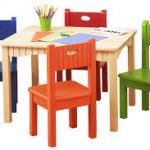 The concept behind calibration tables applies to the colorimeters on the market.
The concept behind calibration tables applies to the colorimeters on the market.
To better understand the original issues, one has to have a basic understanding about the differences between the two forms of color meters that are used in calibration of displays. There are spectrometers and there are colorimeters (also known as tri-stimulus devices). The colorimeter is a measuring device based on the use of red, green and blue filters. The strengths of the device are in its speed compared to spectrometers and better low light capabilities again in the speed department. The weakness of the colorimeter is in the color filters that are used by the device to determine color. When designed, a certain type of red, green and blue filter are chosen for the device. This works best when the device is used on a display that has very similar red, green and blue primary colors to the built in filters. The problem with these filters is that not all displays on the market use the same native red, green and blue colors for their primaries.
When the colorimeter is used on a display that has colors in significantly different locations than what the device is expecting, the meter will provide very inaccurate results.
On the spectrometer side, these devices are not filter based so they make no assumptions about a particular type of red, green or blue. The devices simply look at the color spectrum of the light and thus is never fooled by the display. The devices have accuracy as its strength and speed as its weakness. They are pretty fast on bright patterns, but when dealing with low light patterns, the device response time comes to a crawl. Of course not all spectrometers are the same. The light spectrum may be the same, but what typically separates the devices in terms of quality is the number of samples it takes of the light spectrum. The entry level devices take fewer samples of the light spectrum, say 64 points, while the reference units could take hundreds or thousands of sample points to plot out the same light spectrum chart. Essentially, one looks at a chunky graph versus one that is smooth.
Traditionally spectro devices have cost much more than the colorimeter devices so budget minded DIY’ers tend to stay in the colorimeter camp. More recently, an entry level spectro device like the ColorMunki Photo sells for $400 and the next one up the scale is the X-Rite i1 Pro 2
at $900-$1100.
The colorimeters tended to all sell for under $600 (except for things like the Klein K10 and Hubble that are $4k to $7k) and most enthusiasts settle for things like the Chroma 5 device at about $600, but more recently a device at the $300 price point has arrived that rivaled the performance of $4k colorimeters like the X-rite Hubble. There are more entry level tri-stimulus devices on the market than spectrometers since there are many more into photography than home theater. Many of those photography enthusiasts can use that same colorimeter with the calibration software like Calman and Chromapure.
The premise behind calibration tables is to increase the accuracy of the colorimeter by profiling how that device behaves on many different TV types and technologies on the market. Right or wrong, the colorimeter will yield a series of results for different types of displays. These same tested displays are then re-analyzed with a high end spectrometer like a Minolta CS-2000 which is laboratory grade equipment selling in the $40k range. The differences between the two measuring devices are calculated and correction tables are developed for the inexpensive colorimeter device. From a math perspective, think of it like this …
Tri-stim device reads “6800” on a particular display … say a DLP projector.
Spectrometer reads “5900” on the same display.
We know that the spectrometer reading is the correct one so we figure out the difference. 6800 – 5900 = 900. This difference of -900 will now be used when the user tells the program they are using a tri-stimulus probe on a DLP projector.
So if the tri-stim device actually reads 9550, the program will take the raw data from the probe and do a little math with it. It looks up the offset file for DLP projector that says use “-900” as a correction factor. This is applied to the raw number of “9550” as read by the meter as such “9550 – 900 = 8650.” The program reports the probe reading as “8650” and that is what the user sees on the computer screen.
What gets developed for the tri-stim probes are files for Plasma displays, LCD-CCFL displays, LCD-LED white displays, LCD-LED color displays, DLP displays, LCOS displays, SXRD displays and so forth. What a great way to give an inexpensive measuring tool the accuracy of the reference spectrometer. Let’s see how this works in practice …
First up, let us look at the promise of what the calibration tables are supposed to deliver. I have three calibration runs done on a Panasonic LCD-CCFL display in my office; the first run is done by the Jeti Spectro device and the second run was with the C6/X-Rite i1Display Pro tri-stim colorimeter using solely its calibration tables. The third run is with the C6 profiled to the Jeti.
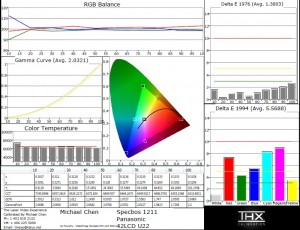
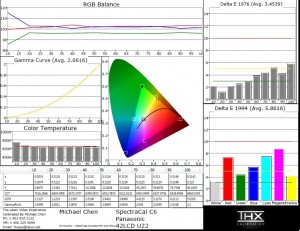
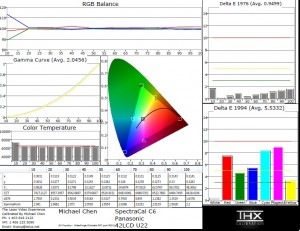
Although the calibration tables do not provide for a perfect solution here, the end result with just the C6 and its calibration tables are pretty close to what the Jeti spectro reads. The error difference is two or so which makes visible detection hard on the bright end. Did one really think that a $300 meter would equal the performance of a $11,000 device? That would really be wishful thinking. On the other hand, the profiled C6 gives a set of readings that are virtually identical to the Jeti Spectro device.

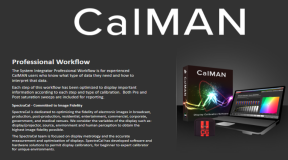
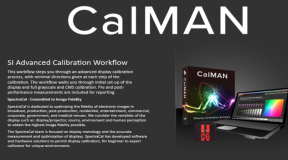
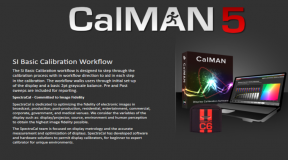
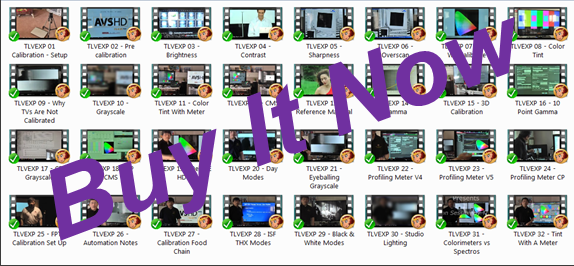
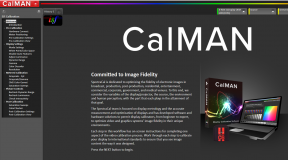
25 Comments
Alex
(January 16, 2012 - 7:44 am)Can I get a datestamp on this article?
It’s a very very good article, by the way. Albeit depressing for the owners of colorimeters. I suppose the best would be to own BOTH the iPro and a colorimeter so you could get the speed and accuracy of both on a given display.
Randal
(January 25, 2012 - 8:49 am)Excellent article. For some enthusiasts economic situations could exist where the purchasing of a $1000 spectrometer is out of the question or to even borrow or rent one again is out of the question. Even if one does have such a equipment; how accurate is the reference unit?
tlvexp
(January 25, 2012 - 9:22 am)A man with two watches never knows what time it is.
I’m not telling everyone to rush out and buy a spectro. The i1 pro can usually be found for under $1000 and the Color Munki Spectro is usually well under $500. The article simply presents the argument that one should not put blind trust in calibration tables. They are not always right … or in the case demonstrated in the article … one was close and three were much further off. The sets were not cherry picked … they were simply the 4 sets I decided to put the meter to.
There is a way to make the tables better. They just are not there yet, but hopefully adjustments will be made and the accuracy will improve.
The thing about the spectros as mentioned in the article is that their behavior does not change depending on the type of TV technology you ask it to read. They are consistent on LCD … Plasma … LCD/LED … DLP … OLED … LCOS … it is not a Wheel of Fortune where you cross your fingers not knowing what the meter results will look like.
I’ve added a shot of the same panasonic LCD set, but using my aging i1 Beamer / pro. This is the verification I expect when I put a second meter up to a TV. I don’t expect it to be identical, but I do expect it to be reasonably close … and it is. Therefore I have confidence in the i1 and my Jeti.
Regards
HT_GUY
(January 25, 2012 - 11:29 am)Can you use the i1Pro to measure the LG LED-LCD? Since the C6 was way off on that TV, it would be the best example to show how much more accurate the i1Pro can be.
tlvexp
(January 25, 2012 - 1:40 pm)I will work on that … easier said than done … a lot of sun light in that room. 🙂
HT_GUY
(January 25, 2012 - 3:35 pm)Thanks for the update. This really makes the case for owning an affordable spectrometer for DIY’ers like myself. Colorimeters are not bad devices, they just need to be paired with a spectrometer for absolute accuracy.
Also, it seems your i1Pro from 2002 has maintained its accuracy very well over a decade. Another reason to own a spectrometer in my opinion, since it stays accurate and you don’t need to send in your colorimeter for re-calibration as long as you use the spectrometer to profile it each calibration session on each display.
venkatesh_m
(January 27, 2012 - 12:20 am)Michael,
The i1 seems to be reading luminance a lot lower (for both the panasonic and the lg display). I am not sure if this is measurement issue or just a case of reporting on the charts as the luminance seems to be lower by about 30% for all values.
tlvexp
(January 27, 2012 - 3:47 am)Good observation. I will take a look at the way the i1 pro was mounted for these readings which was on a tripod about four inches from the screen. Will see what the difference is with direct contact. In a real world application, it might mean that light output gets set to a higher level as a result, not that big of a deal. Is that necessarily a bad thing? From a contrast setting perspective, the eye fatigue consideration trumps exact light settings anyway. A mental correction factor could always be added too … Take reading and multiply by 1.5
Just don’t be using the i1 pro for studio reference set up work … which it isn’t supposed to be for anyway. 🙂
tlvexp
(January 30, 2012 - 10:26 am)I did a verification with the i1 pro … and it reads the same light output when in contact with the screen or when it is 4 inches from the screen on the tripod.
Good idea to stick with the multiplication factor when trying to figure out exact readings.
HT_GUY
(February 4, 2012 - 9:47 am)Would a new i1 pro still read luminance a lot lower than the C6?
tlvexp
(February 13, 2012 - 8:52 am)I had Ray take a few readings with his C6 and his i1 Pro … a real one. The luminance readings were identical to the c6. Seems some progress was made over the 8 years to when he got his unit. I get to use the 1.5X multiplier … he does not need to.
HT_GUY
(February 23, 2012 - 1:01 pm)Based on this data, it appears tables for LED-LCD’s have issues but for CCFL-LCD’s not necessarily so. Do you have access to any other CCFL-LCD’s to see if this theory could be true? Is CCFL backlighting more consistent among LCD displays than LED backlighting?
tlvexp
(February 24, 2012 - 10:45 am)Did two other LCD CCFL displays in my home … a 46″ Sony unit from 2007 time frame and a 23″ Samsung computer monitor (2009). Delta E average error was 1.0 for the Sony and 0.6 for the Samsung. Largest single deviation was about 1.5. There is consistency here and with the Panasonic, the tables can get within a range of 2.0 or better … consistently.
HT_GUY
(March 26, 2012 - 11:16 am)How do the tables hold up to plasma displays?
tlvexp
(March 26, 2012 - 12:00 pm)Answer … I don’t know. I will have a chance to play with a bunch of plasma sets in the coming weeks so will see what happens.
HT_GUY
(April 20, 2012 - 11:33 am)Looking at the latest addendum, it seems that FOV does not alter the results from the Jeti at all. Also, the calibration tables seem to have worked quite well on this particular display.
Was the new wide gamut white LED table used on the C6 for this test? SpectraCal claims the new table was added in response to the discrepancies noted in earlier tests within this article on LED-LCDs. I’m assuming the standard white LED table was used in the past for the LED-LCDs tested in this article.
tlvexp
(April 21, 2012 - 5:57 pm)Latest version of Calman so latest tables. I try both LED settings and pick the one that is closest to the JEti. Problem is … I can confirm this with my reference tool. Others not as fortunate. And how exactly do you know if you should be choosing a white LED type of a color LED type? The User manual does not exactly say stuff like that. 🙂
HT_GUY
(April 22, 2012 - 5:13 pm)I guess sites like Panellook and forums like AVS can help you find out exactly what the backlight type is.
I thought all current LED-LCDs use white LEDs and that RGB LEDs were a thing of the past. Also, standard gamut white LED sets have smaller than Rec. 709 gamuts while wide gamut LED sets have standard sized gamuts like those tested in this article. That’s what I read in the SpectraCal forum.
Wouter
(November 13, 2012 - 8:59 am)I have a question about the i1 pro spectro to which I cannot seem to get an answer to. At lower light levels, say below 30% white, it is known the i1 spectro takes a lot more time to do a reading. But is it still accurate? I’ve heard people say it loses a lot of accuracy at lower levels as well. But when I read 10% and 20% on my panny VT50 plasma, I do get the same reading consistantly. Now I do not know if those readings are accurate, but I would expect that if they were inaccurate, the reading would turn out differently with each taken reading…
tlvexp
(November 13, 2012 - 10:07 am)The i1 Pro bottom end issues are not so much a 10-20% issue as opposed to a light output issue. 10% on a typical projector in a dark room is not the same as 10% on the VT50 plasma tv. If the readings at 20% and 10% appear linear and relatively in line with 30% and everything else, you are good. The i1 pro is just fine for your application.
On the projectors, at the 10% level … and sometimes the 20% … the readings are simply wildly inconsistent.
Remember to always use your eyeballs to double check the probe results. On a projector, the i1 pro might sometimes return a reading that says the pattern is too green … but visual inspection says no.
For a double check on the dark end on your plasma … do a dark reading and then immediately take a few readings of those dark patterns. You get the best results than. We do that on the projectors too especially on the dark end. We do a dark reading every few minutes so that we can be sure of the results or when to disregard them.
wouter
(November 14, 2012 - 5:57 am)I would like to ask you, how do I best take a dark reading? With the white tile ( I have the i1 2 spectro), or is a black bag over the device enough? Also, in chromapure, can you do in-between dark reading? I only manage to do so by disconnecting the device (not fysically, but in the programm) and then selecting it again, so it automatically asks for a dark reading.
Thanks for taking the time to answer my questions 🙂
tlvexp
(November 14, 2012 - 11:54 am)There should be an option under the tools menu at the top for taking a dark reading.
I’ve done things like putting the unit up to the clothing or on my lap for dark readings. It is all the same. A dark surface. Even my hand when in dark rooms.
regards
HT_GUY
(May 5, 2013 - 10:18 am)Regarding taking dark readings when using the i1pro in contact mode, is there any easy way to do this without having to take the meter off-screen and then be forced to re-position it?
tlvexp
(May 5, 2013 - 5:20 pm)A few mm won’t make a difference and I can just use a finger to block the light. It it is off by a few mm and the readings are that different, then you have bigger problems. 🙂
Dell U2414H UltraSharp - Page 4
(February 20, 2014 - 11:16 am)[…] με λίγα λόγια, πρέπει αναγκαστικά να σου βάλω ένα link από το site του Michael Chen και να σου ζητήσω να αφιερώσεις ένα μισάωρο από το […]